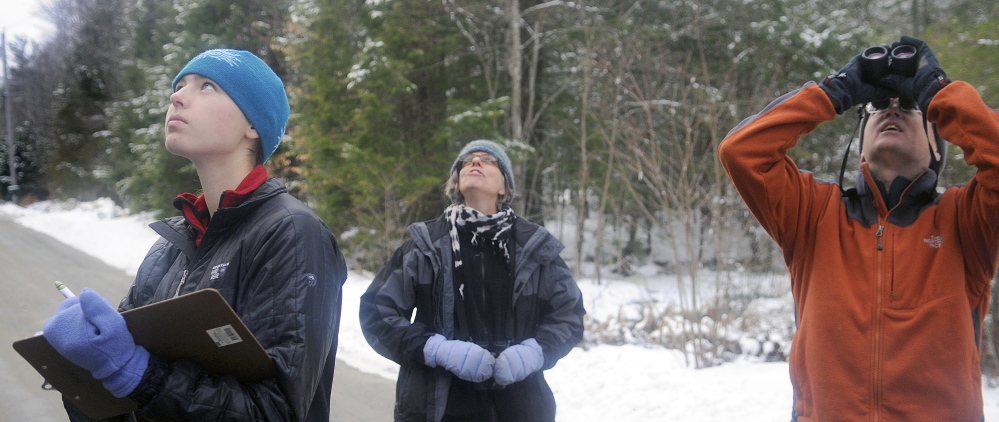FARMINGDALE — Sunday’s bird count started off like they often do for Glenn Hodgkins. A chickadee and a nuthatch, common in Maine, were the first birds he spotted along Northern Avenue.
“Those are the two you’d expect,” he said. “The next are blue jays and crows.”
The next birds he spotted were blue jays and a crow, in that order.
On Sunday morning, Hodgkins, of Hallowell, was birding as part of the National Audubon Society’s annual Christmas Bird Count, which takes place across North America for about three weeks in December and January. In the Augusta area, 30 volunteers set out to count species in a region within a 7.5-mile radius around the Maine State House.
Others were scheduled to fan out from more than 30 other locations in Maine from Presque Isle to York County by January. The count provides bird enthusiasts with an opportunity to hit the road with their binoculars and scopes, but the data they collect aren’t all that relevant locally, said Cheryl Ring, the Augusta area count’s organizer.
The National Audubon Society says the data collected across the continent are the most comprehensive in tracking the movement and population of different bird species. Those efforts have helped the group’s scientists predict how birds will respond to the effects of climate change.
A study found that more than 300 bird species – including 50 in Maine – could lose more than 50 percent of their range by 2080, according to the Maine Audubon Society, which also said the state is seeing high populations of birds that were traditionally rare in Maine and common farther south, such as the Eastern bluebird and the red-bellied woodpecker.
“That’s good information for scientists to have – whether a bird is here or whether it isn’t,” Ring said.
Hodgkins, his 17-year-old daughter, Anna, and their partner for the day, Tina Wood of Gardiner, searched a region starting on the west side of the Maine Turnpike in Farmingdale and ending at Cobbossee Lake in West Gardiner. Anna, a junior at Hall-Dale High School, sparked her father’s interest in birding.
“I started watching birds as a toddler, and I’ve been doing it ever since,” she said.
Hodgkins said his daughter could identify 50 different bird species by age 2. They started doing the bird count nearly a decade ago. Last year, they saw some rarities, including the sharp-shinned hawk and the northern shrike. On Sunday morning, they saw mostly common birds. An American tree sparrow, a small foraging bird with a rusty cap and gray face often found wintering in Maine, was one of their better finds.
The trio left their area briefly to go to the end of Outlet Road in Manchester, where Hodgkins took out his scope and found approximately two dozen common goldeneye ducks, which he said are somewhat rare on inland lakes in Maine. By day’s end, counters would go to Augusta, where they would compile the overall area numbers.
Hodgkins said the counters aren’t competitive with one another, but all want to see rare birds. But if they don’t, it’s not a day wasted, he said.
“I’m always surprised by how many birds are out there if you actually look for them,” he said.
Send questions/comments to the editors.


